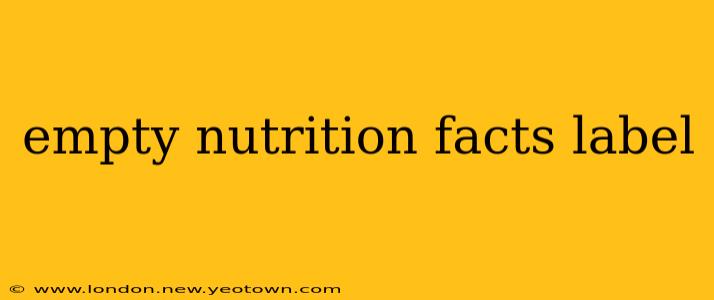Have you ever stared at a food package, expecting to find a helpful Nutrition Facts label, only to be met with…nothing? A blank space where vital nutritional information should be? It's a frustrating experience, leaving you wondering what exactly you're consuming. This isn't necessarily a sign of shady practices, but it does require understanding. Let's unravel the mystery behind an empty nutrition facts label and what it might mean.
Why is there no nutrition information on this food?
This is the most common question people have when faced with a blank nutrition label. The answer isn't always straightforward. Several factors can contribute to the absence of this crucial information.
One primary reason is that the food might be exempt from labeling requirements. Certain foods, like those sold in small establishments or those with very simple ingredients (like plain salt), often fall under exemptions. Regulations vary by country and region, so the specifics depend on where the food is produced and sold. The FDA in the US, for instance, has specific rules defining exemptions.
Another reason could be the packaging size. A very small package might not have enough space to accommodate a standard nutrition facts label. However, this is relatively rare, as manufacturers usually find creative ways to include essential information, even in smaller packages.
Perhaps the most important consideration is that the product is new or recently reformulated. A product undergoing a significant recipe change might not yet have its updated nutrition facts finalized and printed on the packaging. Manufacturers often go through a testing and approval process which takes time to complete.
What does the lack of a nutrition facts panel mean?
The absence of a nutrition facts label can leave consumers feeling uncertain and potentially concerned. It doesn't automatically mean the product is unsafe or unhealthy, but it certainly limits your ability to make informed dietary choices. Without the label, you're deprived of essential information, including:
- Serving size: Understanding portion control is crucial for managing your calorie intake and overall health.
- Calories: A key element in weight management and overall energy balance.
- Macronutrients: The amounts of fats, carbohydrates, and protein, all essential for various bodily functions.
- Micronutrients: Vitamins and minerals that contribute to overall well-being.
The lack of transparency can be especially problematic for individuals with dietary restrictions or allergies.
How can I find out the nutritional information if it's not on the label?
Don't despair! If you're truly curious about the nutritional content of a product without a label, you can take several steps:
- Contact the manufacturer: This is often the most effective approach. Their customer service department should be able to provide the complete nutritional breakdown.
- Check their website: Many companies post detailed nutrition information online, often accessible via the product page.
- Look for similar products: If the product is similar to others that do have nutrition labels, you can use those as a rough estimate, understanding that variations will exist.
Remember that it's essential to exercise caution when relying on estimates.
Is it illegal to sell food without a nutrition facts label?
The legality of selling food without a nutrition facts label depends heavily on local regulations and the specific product in question. As discussed earlier, certain exemptions exist for various reasons. However, in most jurisdictions, there are rules in place to prevent misleading practices, and the absence of a label might not be permitted for most manufactured foods intended for large-scale sales. To be safe, always check the relevant regulations in your area.
Are there any other reasons why a food label might be incomplete?
Aside from a completely blank label, you may encounter instances where parts of the nutrition facts label are missing. This usually happens due to errors during the printing process. If this occurs, contact the manufacturer directly; it could point to a wider issue with the product's labelling.
In conclusion, while an empty nutrition facts label might seem alarming, understanding the various reasons behind it can help you navigate this situation and make informed choices about your food intake. Always prioritize transparency and contact the manufacturer if you need clarity. Remember that your health depends on making informed decisions, and access to nutritional information is crucial to that goal.

